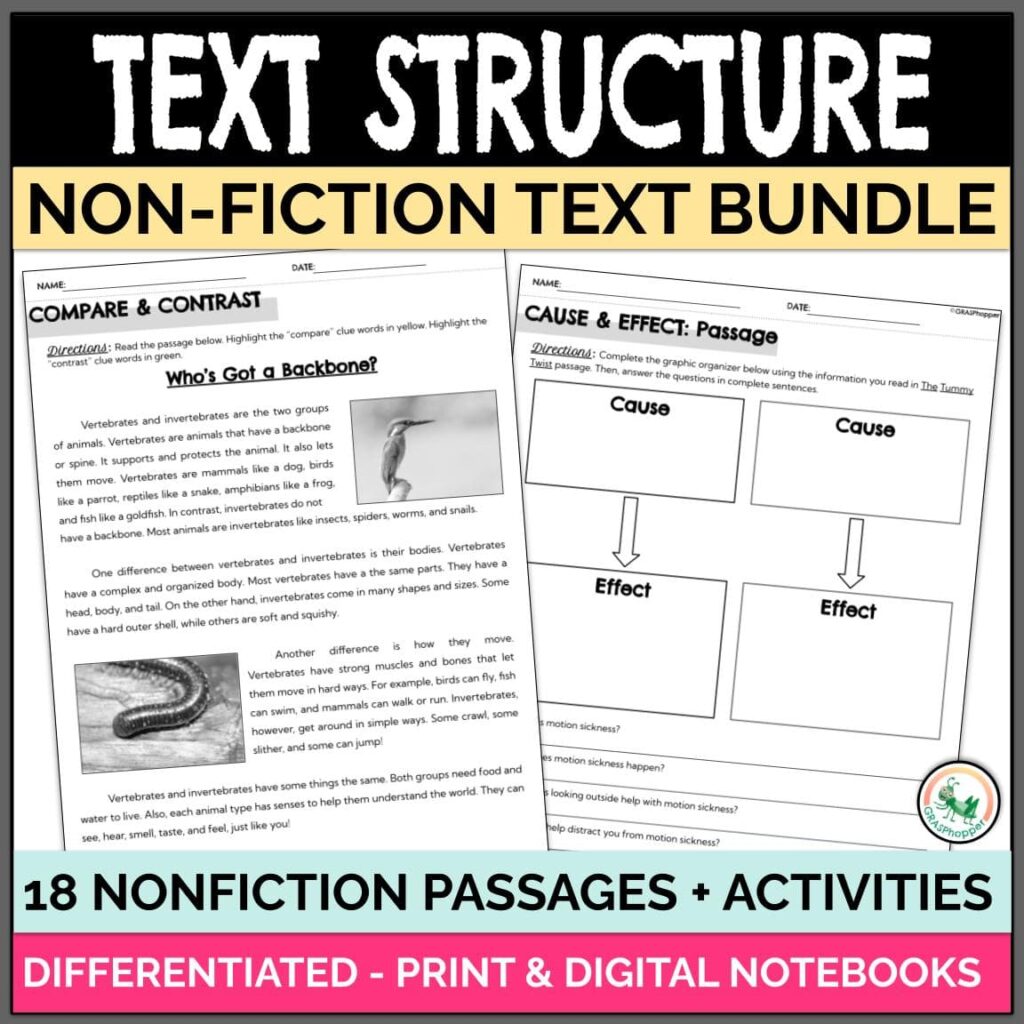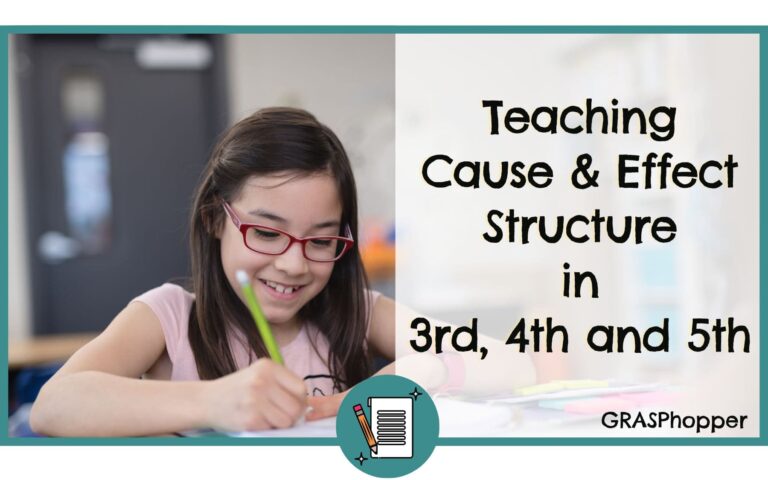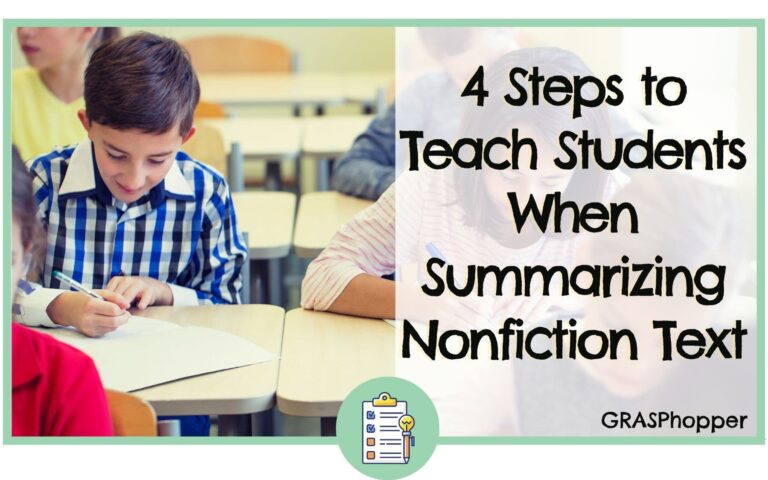Reading comprehension is one of the most important tools a student can have. When it comes to nonfiction texts and passages, it can definitely be more difficult for students to interpret the main idea and details during reading. When standardized testing happens, students will see a large number of critical thinking questions and be required to answer many questions about nonfiction passages.
Let’s chat about 5 types of nonfiction text structures to teach in 3rd, 4th and 5th grades so your students can feel confident come testing time.

Nonfiction Text Structure in 3rd, 4th and 5th Grade
In 3rd, 4th and 5th grades, understanding the many different text structures of a nonfiction passage becomes even more important due to standardized testing. Many tests will have students read a nonfiction text and answer critical thinking questions about it.
It can absolutely feel almost impossible to teach or even just expose students to the various questions that they may come across.
So what’s our recommendation?
Focus on questions that target the 5 main types of nonfiction text structure that tend to pop-up most often.
Let’s dive in to what those are!
1. Cause and Effect Nonfiction Text
Cause and effect reading passages will always show up on standardized tests so they are the perfect type of nonfiction ELA text to start with!
Understanding cause and effect helps students grasp how things are connected and why they happen, which will hopefully make reading and learning more enjoyable for them!
When students read nonfiction texts, focusing on cause and effect can help them follow the events in order and figure out why certain things happen.
This skill is important for tests because questions often ask about these types of relationships. Teach your students to keep an eye out for words like “because,” “since,” and “due to” – they all signal cause and effect in the text. Also, make sure they pay attention to the order of events to better understand how one thing leads to another.
Watch the Cause and Effect Teaching Video
2. Compare and Contrast Nonfiction Text
Teaching students to compare and contrast is a total game-changer because it will help them to see the big picture and details at the same time. When you can compare, you find what’s alike, and when you contrast, you spot the differences.
On standardized tests, many questions will ask students to compare and contrast things that they just read about so it’s an important nonfiction text structure to teach.
Teach students to keep an eye out for words such as “similar,” “different,” “alike,” and “but” – they are major clues to finding comparisons and contrasts in the text.
Watch the Compare and Contrast Teaching Video
3. Problem and Solution Nonfiction Text
Knowing how to identify a problem and solution absolutely makes your students better critical thinkers. Think of it similar to solving a puzzle.
In standardized tests, questions often focus on these problem-solving skills, making them crucial for success. Teach students to watch out for words like “issue,” “challenge,” “solve,” and “solution” – they are hints to finding problems and solutions in the text. Also, teach kids to pay attention to the details that explain what went wrong and how it got fixed.
Watch the Problem and Solution Teaching Video
4. Description Text Structure Passages
Knowing how to identify descriptive details helps your students visualize and experience what they are reading. In standardized tests, questions might ask you to pick out descriptive elements, making this skill super valuable for your students to learn.
Teach your 3rd, 4th and 5th graders to look for words like “describes,” “details,” and sensory words like “smells,” “sounds,” and “feels” – they will guide you to the descriptive parts in the text. Also tell them to pay attention to the details that create a mental image and bring the text to life in their mind.
Watch the Description Teaching Video
5. Sequencing Events in a Nonfiction Text Passage
Last but not least, let’s chat about sequencing events in a nonfiction text passage. Being able to put events in order to understand how things happened is huge for students trying to comprehend nonfiction material.
In standardized tests, questions often ask about the order of events, making this skill extremely useful for students to understand. Teach students to keep an eye out for words like “first,” “next,” “then,” and “finally” – they guide you through the sequence in the text. Also explain to pay attention to the chronological order of events, which makes it easier to understand how one event leads to another.
Ultimate Nonfiction Text Structure Passages & Activities for Test Prep
To help students even further with understanding these 5 nonfiction text features and prepare them for standardized testing, you may want to grab the entire Nonfiction Text Structure Bundle.
The bundle includes 5 different resources that focus heavily on the different types of nonfiction text structures discussed above and is loaded with over 200 pages of activities, worksheets, passages, graphic organizers, digital notebooks and tons more!
Each resource includes activities, high-interest text structure passages with differentiated questions, graphic organizers, and text structure anchor charts. Comprehension questions are also included so everything is already done for you. Just print and save yourself some time for test prep! With the Nonfiction Text Bundle, you also save money in comparison to purchasing each resource separately.
YOU MIGHT ALSO LIKE: SURVIVING ELA TEST PREP: 3 SKILLS TO TEACH!
We want to know…what types of nonfiction text do you feel are important to teach?
















